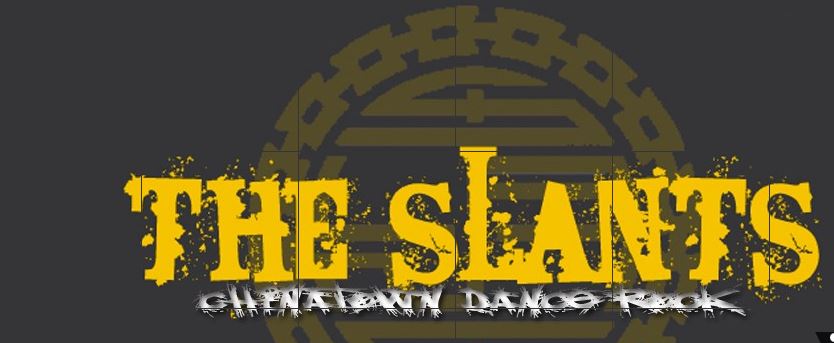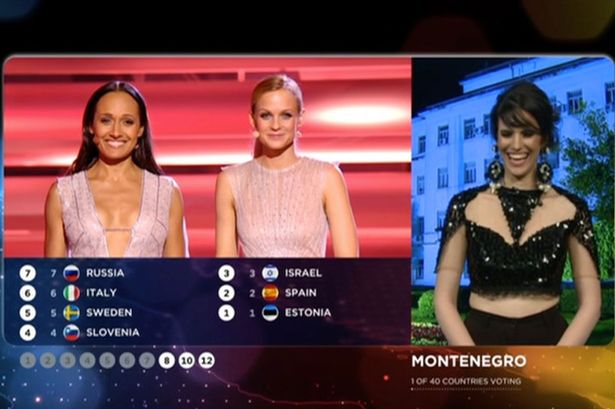
This is the second installment of a two part interview with Simon Tam, bass guitarist and founder of The Slants — a Portland-based rock band that is part of an ongoing legal battle with the US Patent and Trademark Office concerning their effort to brand the band’s name. (Find part 1 of this interview here and read more about their case here.)
Culture on the Edge: As we understand it, when you came up with the idea for the group, about ten years ago, you intended from the outset to have an all Asian-American band. So, with the above question in mind, what was/is your definition of “Asian” and how do you understand it to differ (if at all) from the compound identity designator used here in the US, “Asian-American”? In practice (say, when recruiting new members), do the current members of the band have either regional limits in mind (e.g., is Asia minor Asian?) or, perhaps, linguistic or generational (what if one was born in the US and speaks only English?)? Might you not all even agree on how you use that identity marker? Or, instead, is it a big tent designator for you that, perhaps, actually reflects how people with broad, Asian-based ancestry are seen by others, such as the North American non-Asian majority? So who sets the band’s identity definition?
Simon: My original goal was to have a band comprised primarily of Asian Americans, those who have a bi-cultural understanding as well as those who ethnically identify with people of Asian origin. I believe that Asian Americans are a specific group who have a distinct identity because they have a different experience than Asians (even first generation immigrants) do. That being said, we’ve never distinguished on any criteria, such as by language, birth, or generational characteristics. We’ve had band members who were born outside of the U.S, those who were adopted, those who grew up with a strong connection to their heritage, and those who did not. We haven’t had any conflicts over identity (yet), we mainly ask applicants to self-identity and see if they have some level of awareness as it pertains to these kinds of issues.
We’d hate to imply that the Lanham Act has anything to do with the internment of Japanese Americans during World War II, but it is interesting that 1946, when the Act was passed (whose definitions of scandalous and immoral you’re now contesting) is also when the War Relocation Authority (which ran the internment camps) was also terminated (by executive order of President Truman, on June 26, 1946). So, while not suggesting any link between these two, the date 1946, and, specifically, the way Japanese Americans were treated during the war, provides a curious point of reference for those wishing to think about how far we’ve come, in the past 70 years, in terms of the role people of Asian ancestry play in contemporary US culture. So how far have we come? Our notions of free speech have certainly changed a lot but does it seem to you that we’ve moved very far over the past seven decades in terms of how people of Asian ancestry are represented in the US or the agency that they can exercise, even just in day-to-day life, let alone the courts?
Simon: I definitely don’t think the Section 2(a) of the Lanham Act was related to the internment camps, but there have certainly been several curious coincidences over the last few decades. My case is no different: the original date set for my first appeal was February 19, the anniversary date of Executive Order 9066, which led to the detention of Japanese Americans.
In terms of Asian Americans in contemporary US culture, there’s no doubt that there has been substantial progress: we have Asian Americans reflected in most industries, including a handful of elected seats, on prime time television, and especially in tech and medical fields.
However, that kind of agency and progress tends to be reserved for groups that have assimilated or who have been able to amass resources to progress. When individual community groups are examined, there is significant inequity in terms of employment, education resources, health disparities, and more. This is especially the case for newly immigrated families from Southeast Asian, regions including Nepal, Cambodia, Laos, and the Micronesian Islands.
It seems that the court system, education and employment opportunities, and other resources are not favorable to non-European immigrants or low-income families. Of course, this disproportionately affects Asians and Asian Americans.
That part of the globe now referred to as Asia is a pretty big place, of course, and, depending to whom you speak, it’s not necessarily clear where it begins or ends; and the countries that today are generally said to comprise it, like any regional collection of countries, have their share of differences and historical disagreements (even overt conflicts). So while seeking to rebrand such terms as “slant,” when used as a derogatory racial term, what work do you also see such a rebranded term doing in creating a larger, shared identity for subgroups today who might otherwise see themselves as sharing little in common? Or are the points of possibly different ancestry so far away for the generation of which you’re a member that onetime differences (between, say, this person’s Korean or Vietnamese and that person’s Japanese or Chinese ancestors) are now unrecognizable against the backdrop of all being “Asian American” today?
Simon: The term Asian is constantly evolving and comprises an incredible diversity of people, some of whom have the “epicanthic fold” or “slant” that people exclusively attribute to Asians, and some who do not. The process of reclaiming the term doesn’t really depend on evolving definition. In fact, when our band uses “THE SLANTS,” it’s a specific reference to our slant on life, or perspective, as people of color, not necessarily the shape of our eyes. That’s one of our approaches in dismantling the stereotype that we all share the feature. For those who approach “slant” in a re-appropriated manner (such as Asian American activists who have been doing so for the past few decades), it’s more to do with our ethnic origins and how they have been systematically used to target and denigrate our communities in a like manner – the individual country of origin doesn’t matter since our community is treated as one, monolithic anyway. It’s a sword that cuts both ways: we can use it to increase our numbers, empower disparate groups, and unite what includes divided Asian communities, but it sometimes reinforces the notion that Asians are “all the same” as well.
As mentioned previously, Asian Americans have a unique perspective as being bi-cultural, descended from Asian immigrants but are often treated as perpetually foreign, as other. The Slants reflects that experience, not necessarily that of current “Asians,” though there’s no doubt that there’s a strong connection between the two.
 That an attempt to give a band an edgy and catchy identity has turned into a legal, branding and licensing issue says something about how identity (as well as the music industry) works today; apart from the band wining the right to control its name and merchandizing, what do you think other self-identified Asian Americans might gain if you’re successful in this appeal?
That an attempt to give a band an edgy and catchy identity has turned into a legal, branding and licensing issue says something about how identity (as well as the music industry) works today; apart from the band wining the right to control its name and merchandizing, what do you think other self-identified Asian Americans might gain if you’re successful in this appeal?
If our band is successful in this case, it opens up the opportunity for other marginalized communities to have their re-appropriated marks to be recognized and protected as well. I hope it ensures that ethnic identities are not used as a determining factor for “scandalous” laws again, at least for trademark registration. More importantly, I hope that it inspires a conversation about race, systemic issues, and how these are deeply integrated into our law system. The law that we’re fighting has been disproportionately affecting minorities for nearly 70 years now and it exposes the lack of cultural competency (especially in the way of identity politics) of the U.S government. For example, terms like “chink,” “jap,” and “oriental,” are seen by Asian Americans as far more disparaging to our group that “slant,” yet they’re all terms that have registered trademarks. In fact, the only person to have been denied a trademark registration on the term “chink,” was an Asian American who was trying to re-appropriate it. It’s a little like my case: over 800 trademark registrations for “slant” have been submitted to the US Trademark Office. Only one, in all of US history, was denied registration for being disparaging towards Asians – and that, of course, is my application for an all-Asian American band.
Our sincere thanks to Simon for taking
the time to answer our questions.

 Last week the Edge posted a brief
Last week the Edge posted a brief  Over the next couple of days this led to a series of tweets and emails and resulted in the following questions, posed by us here at Culture on the Edge, to Simon, concerning identity and the band’s ongoing efforts to register a name that, at least according to the US government, is inappropriate because it can be read as a racial slur.
Over the next couple of days this led to a series of tweets and emails and resulted in the following questions, posed by us here at Culture on the Edge, to Simon, concerning identity and the band’s ongoing efforts to register a name that, at least according to the US government, is inappropriate because it can be read as a racial slur.
 See the scene, from season 5 episode 7,
See the scene, from season 5 episode 7,  While not aiming to trivialize ongoing conflicts elsewhere in the world, I couldn’t help but make a connection between the above
While not aiming to trivialize ongoing conflicts elsewhere in the world, I couldn’t help but make a connection between the above  Like Wimbledon, I watch the Eurovision finals each year — we started doing it a few years ago. I was in Greece during the finals back in 2009 (
Like Wimbledon, I watch the Eurovision finals each year — we started doing it a few years ago. I was in Greece during the finals back in 2009 ( Have you heard the recent story, in the US, about musicians seeking to trademark their band’s name — The Slants — and how the US’s
Have you heard the recent story, in the US, about musicians seeking to trademark their band’s name — The Slants — and how the US’s  A story the other day on National Public Radio’s morning show was on the US Republican party’s ongoing efforts to recruit more voters from the Latina/o community.
A story the other day on National Public Radio’s morning show was on the US Republican party’s ongoing efforts to recruit more voters from the Latina/o community.
 In honor of Don Draper’s departure from our TV screens last night I thought I’d share a piece of advertising that makes evident that it’s not the words you use but how you say them.
In honor of Don Draper’s departure from our TV screens last night I thought I’d share a piece of advertising that makes evident that it’s not the words you use but how you say them.